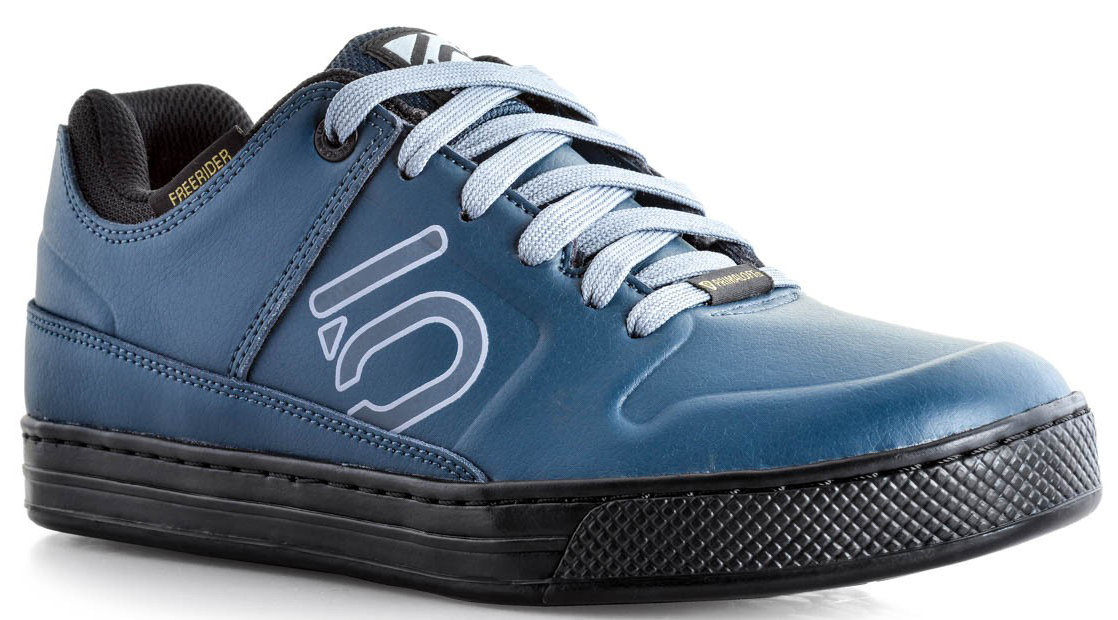
Five Ten Freerider EPS
Size Tested: 10 US
Stated weight: 496 g (Size 9)
Stated Features:
- Stealth S1 outsole with Dotty tread
- Primaloft insulation in forefoot and tongue
- Single piece leather forefoot
- Insulated, heat-reflective footboard
MSRP: $140 low-top, $150 high-top
Test locations: Bozeman, MT
Days tested: ~ 30
Intro
We reap the benefits of super sticky rubber and cool, breathable shoes all summer long, but what happens when the weather takes a turn, and those of us bold enough to brave winter by bike get cold feet?Several cold-weather shoe options have popped up for clipless riders, but flat pedal riders have been left with few options to prevent cold, soggy toes in inclement weather.
Several cold-weather shoe options have popped up for clipless riders, but flat pedal riders have been left with few options to prevent cold, soggy toes in inclement weather.
This is where the Freerider EPS, which stands for Elements Primaloft System, comes to the rescue. I tested the low-top version ($140 USD), but it’s also available in a high-top version ($150 USD), each with three colors to choose from.

Compared to the Freerider ELC that Cy Whitling reviewed, the Freerider EPS adds that extra bit of insulation and water resistance that enables riding in the nastiest of conditions, whether that entails sloppy mud rides, or sub-freezing outings.
Fit
My feet usually float somewhere between the 9 and 10 size mark, and the size 10 Freerider EPS fit true to size. I feel that if I were to size down to a 9 my toes might occasionally jam into the front of the shoe since there’s no ratcheting buckle or strap to keep your heel locked in place like with a clipless shoe.
Like most shoes from Five Ten, the Freerider EPS has a distinctly wide toe box, but by no means does it feel bulky or sloppy on my narrow feet. And the added insulation doesn’t make the shoe feel any narrower than the traditional Freerider and Freerider Canvas.
Upper
A single piece of leather on the forefoot eliminates seams and keeps water and snowmelt off your precious toes. Unlike the lace flap of the Freeride ELC, the Freerider EPS relies just on a fully gusseted tongue to keep water and mud out.

The one-piece forefoot is truly waterproof, and not once did water seep or soak into the material. From my first outing to my last, I was happy to watch water beading and rolling right off the surface of the shoe.
Sole
Five Ten’s Stealth rubber outsole doesn’t need an introduction, since it’s already regarded as the industry standard in pedal-grabbing, non-slip goodness.
And while thirty or so days on these shoes doesn’t paint a complete picture of their durability, the Stealth S1 sole shows no damage from the ultra long and sharp pins on my E*Thirteen LG1+ pedals, which have torn up the soles of comparable shoes after a dozen or so rides.
The sole of the Freerider EPS is stiffer than on the standard Freerider, which inspired extra confidence when riding fast, and made it easier to transfer power to the pedals. However this comes at the expense of “pedal feel,” making it difficult to determine exactly where my foot was placed on the pedal at all times. But just like with a skateboarding shoe, there’s always tradeoff between impact absorption and sensitivity.
The stiffness of the sole makes the shoe just slightly awkward to hike in, but it’s worth the trade-off in how well it works on the bike. When it comes to hiking traction, it’s obvious that this sole is designed to grip pedals, not ice and snow.
Off-the-bike excursions in snow required that I dig my toes or heels in for traction. So no, these aren’t winter hiking boots with bike tire-like lugs, but the grip afforded by the Stealth S1 sole, even on snowy pedals, is well worth the sub-par hiking performance in my book.
Impermeability vs. Breathability
I have yet to find a flat pedal shoe better suited for dealing with sopping wet and cold conditions, but it definitely has a sweet spot. The Freerider EPS shines in temperatures hovering around freezing, and fares well in colder climates if wool socks are worn.
Wet outings in warmer weather up to fifty or sixty degrees are also great with the Freerider EPS, but if it’s not very wet out, I prefer to don the more breathable Freerider ELC. Whether it’s hot or cold out, I battle with sweaty feet, so as soon as the temperature rises above forty degrees, I prefer to wear a more breathable shoe. If you don’t have the same problem with sweaty feet, the Freerider EPS will likely serve you well in a wider range of weather conditions.
Bottom Line
I’ve begun to use the Five Ten Freerider EPS for everything; fat biking, walking around town, and even cold BMX sessions are comfortable, and dare I say stylish, in this shoe. Five Ten has made a very versatile shoe for those too attached to their bikes to let a bit of bad weather get in the way of riding.
